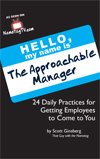
Past Posts In This Series
ATTRIBUTE #1: Have conversations that change people.
ATTRIBUTE #2: Meet people where they are.
ATTRIBUTE #3: Vortex people in.
ATTRIBUTE #4: Share the spotlight.
Today’s Post
ATTRIBUTE #5: Respond to what IS.
– – –
PICTURE THIS: You’re a beginning Bikram Yoga student.
It’s only your third class ever. The room is sweltering. Sweat pours out of your body like a car wash. Muscles you didn’t even know you had ache and burn. Worst of all, your bottle of cold water is running dangerously low.
To make matters more intimidating, surrounding you are all veteran students, most of whom are contorted into pretzel-like positions you’ve only seen in the Olympics.
How would you feel? Uncomfortable? Hopeless? Ready to walk out of the room?
Me too. In fact, during my first few yoga classes, I felt all of the above.
But I’ll never forget what my instructor, JJ, said me during one particular practice…
I remember experiencing a combination of exhaustion and disappointment. I just couldn’t control my breathing. There was no way I could stay in the posture any longer.
So, I fell out.
Which was no big deal. Happens to everyone.
I plopped down on my mat to take a brief rest. JJ noticed, smiled, and said seven unexpected words:
“Thank you for listening to your body.”
Huh.
Thank you for listening to your body? But I messed up! I fell out of posture. Why would the instructor be THANKING me?
And then, as I lay there trying not to pass out from heat exhaustion, it started to make sense.
Although everyone “falls out of posture” from time to time – in yoga or in life – NOT everyone has the experience of an instructor – a LEADER – who positively responds to them without judgment, evaluation or criticism.
JJ just as easily could have said, “Woops!” or “Ooh, tough break…” or “Scott! Get your lazy ass back in the posture!”
But she didn’t. She thanked me for listening to my body.
And I never forgot that.
So, I share this story because I’m curious how YOU – as a teacher, leader, manager, helper, whatever – respond to YOUR people when they “fall out of posture.”
Are you constructive or harsh?
Are you appraising or critical?
Are you judgmental or thankful?
Are you directive or dictatorial?
Are you fascinated or frustrated?
Are you descriptive or prescriptive?
These categories of responses (not reactions, but responses) dance along the fine line of approachability. The challenge is becoming aware of how your words, actions and attitudes shape the behaviors people you serve.
Let’s revisit JJ’s phrase – “Thank you for listening to your body” – and explore the elements behind it that make it successful:
1. It’s rooted in gratitude. Saying thank you is a form of recognition. It demonstrates empathy and concern. What’s more, it immediately puts a positive spin on an otherwise negative situation. It’s the difference between, “Oh, I’m sooooo sorry!” and “Thanks for letting me know about that…”
ASK YOURSELF: How are your words laying a foundation of affirmation and positivity?
2. It’s non-threatening and diffusing. That means “encountering” people (which fosters awareness) as opposed to “confronting” people, (which elicits defensiveness.) It’s the difference between telling an employee, “Steve! Get your butt into my office right now!” versus, “Hey Steve, I need your help…”
ASK YOURSELF: Do your words alienate or engage? Do your words sound like suggestions or orders? Do your ideas liberate or imprison people?
3. It’s fair and unembarrassing. Over the years, I’ve had yoga teachers that will straight up humiliate you during class. And while I “get” why they do it, I don’t find that style to be particular effective. The challenge, as an approachable leader, is helping people, not correcting them. That means offering suggestions, not criticisms. And that means walking the fine line between accountability and EDIT-ability. (Thanks for that last one, Joe Meyers.)
ASK YOURSELF: Are you giving people permission or shutting people down?
4. It’s unexpectedly complimentary. Whenever you attempt to help, correct or improve someone’s behavior, always open with an affirmation or compliment about something they’ve already done correct. This paves the way with positivity and makes people more receptive to receiving feedback.
ASK YOURSELF: What has this person done right that I could compliment first?
5. It’s based on mutual honor and respect. When JJ said, “Thank you for listening to your body,” it felt like we were having a conversation, not a lecture. So, this approach to leadership is the difference between giving people frameworks (which are flexible) as opposed to formulas (which are reductive.)
Think of it this way: In college, do you remember doing the bobble-head-doze-off-jolt-back-awake move during lectures? How many times did that happen during conversations? Answer: Much less.
ASK YOURSELF: Are you giving lectures or having conversations? Do you require progress or perfection?
6. It’s responsive instead of reactive. Reacting is a reflex; responding is a choice. As an approachable leader, if you want to monopolize the listening, don’t bulldoze. Don’t take over. Don’t try to fix or solve. And don’t add too much value to the conversation. Just dance in the moment and respond to the other person’s immediate experience.
ASK YOURSELF: Is this an observation or an accusation? Is this an observation or an interpretation? And are you granting this person enough space to BE and SAY what is true?
7. It’s using non-judgmental, non-evaluative, non-critical language. Every yoga teacher is different. Different words, different teaching style, different everything. And while I respect each instructor’s unique personality, when you have a teacher that’s overly critical or intimidating, your practice suffers as a result. I wonder how YOUR personality is affecting people’s performance levels…
ASK YOURSELF: Is this an observation or a judgment? Are you giving advice, evaluation, or feedback? Are you informing people or controlling them?
OK, let’s recap:
The Phrases That Payses was, “Thank you for listening to your body.”
Now, unless you’re a yoga instructor, I doubt you’re going to say that sentence with any frequency. On the other hand, as a manager, teacher, parent or whatever other role you find yourself in, remember the elements behind those seven words:
1. Gratitude.
2. Non-threatening and diffusing.
3. Fair and unembarrassing.
4. Complimentary
5. Mutual honor and respect.
6. Responsive instead of reactive.
7. Non-judgmental, non-evaluative, non-critical language.
Imagine what would happen to your organization if your daily leadership activities revolved around THOSE practices.
Now if you’ll excuse me, I’ve got to get to yoga class.
I hope JJ is teaching…
LET ME ASK YA THIS…
What do you think makes an Approachable Leader?
LET ME SUGGEST THIS…
For the list called, “8 Phrases That Payses to Reduce Emotional Reactivity,” send an email to me, and I’ll send you the list for free!
* * * *
Scott Ginsberg
That Guy with the Nametag
Author, Speaker, Coach, Entrepreneur
[email protected]
 The world’s FIRST two-in-one, flip-flop book!
The world’s FIRST two-in-one, flip-flop book!
Buy Scott’s comprehensive marketing guidebook on Amazon.com and learn how to GET noticed, GET remembered and GET business!

 Yes, making someone feel “important” and “valued” and “needed” is a HUGE part of being an approachable leader.
Yes, making someone feel “important” and “valued” and “needed” is a HUGE part of being an approachable leader.
 Let’s juxtapose two famous quotations, neither of which Google credits to any one source in particular:
Let’s juxtapose two famous quotations, neither of which Google credits to any one source in particular:



